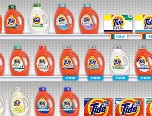 Ellen Byron reports in the Wall Street Journal:
Ellen Byron reports in the Wall Street Journal:
In the laundry room, Americans are prone to overkill. They pour too much detergent into their washing machines.
Generations of consumers have washed clothes with the idea that more soap means cleaner laundry. But the sudsy habits are creating messy problems from dingy clothing to worn machines.
Making matters worse, the latest generation of detergents are concentrated and so require users to use less product-per-washload than ever before. And more consumers are buying highefficiency washers, which need far less water than older models. It’s a combination begging for more careful measuring-something Americans stubbornly resist.
“Before it didn’t matter as much,” says Mary Zeitler, consumer scientist for Whirlpool Corp.’s Institute of Fabric Science. “But now you have to be much more precise in dosing.”
Over the next few weeks, Procter & Gamble Co. plans to introduce easier-to-read plastic measuring caps for its liquid detergent brands, including Tide, Gain, Era and Cheer. The new caps will have more-defined measurement lines inside and bigger numbers that are staggered, not stacked, says Dawn French, P&G’s head of laundry research and development for North America.
Laundry remains a time-consuming chore and one done largely by women. It was the primary household responsibility of 76% of women and 24% of men in a 2007 Whirlpool survey of 2,500 consumers; some 78% of those surveyed do approximately nine loads of laundry each week. The equivalent of 1,100 washloads are started every second of every day, P&G says.
Packaging, in most cases, hasn’t helped. The molded lines and numbers inside detergent caps are hard to read, especially in a dimly lit laundry room. And even though concentrated detergents have been on the market since at least 2007, many caps still hold more than is needed for an average load.
Method Products Inc. this month launched an ad blitz for a new detergent with a pump dispenser, designed to help curb overdosing. Method found that 53% of people don’t use the recommended amount of detergent per washload, preferring instead to guess or, worse, to simply fill the cap up to the top-a practice that wastes more than half the loads a detergent bottle could wash, Method executives say.
“Take a cap and look at where the lines are-nowhere near the top,” says Adam Lowry, co-founder of San Francisco-based Method. “That’s not accidental. In an extremely mature market like laundry, for established players to grow they have to either steal share or get people to use more,” Mr. Lowry says. “They are trying to dupe people into using more product than they need.”
Hogwash, big detergent makers say. And besides, companies don’t want to boost sales by confusing consumers, because they don’t want their customers disappointed in how the product makes their clothes look and washing machines wear. Detergent “overpouring” creates a high, foamy tide inside the machine, lifting soil and lint above the water level so it isn’t rinsed away. That leaves residue on clothing that fades colors and attracts more dirt, they say. Inside the machine, detergent buildup encourages odor and bacteria growth, and leads in time to wear and tear that will require professional attention, washer manufacturers say.
“We’re constantly doing research to try to get the lines easier to read,” says P&G’s Ms. French.
Making the caps difficult to read “isn’t our intent whatsoever,” says Greg Tipsord, general manager of laundry for Henkel A.G.’s U.S. consumer goods unit, which makes Purex detergent. Consumers do so much laundry each week that they consider themselves experts. “They all know there are directions on the back of the bottle,” he says. “They just choose to ignore them.”
Even so, a cap needs to fit a bottle and hold detergent without leaking-two priorities that take precedence over legibility, says Jonathan Asher, a senior vice president at Perception Research Services, a package-design consulting firm. Also, touting that a cap corrects a consumer’s laundry mistakes would be a tricky marketing feat, he says. “You have to avoid implying that the consumer isn’t smart enough to get it right in the first place.”
Through much of Europe, detergent premeasured in tablets and sachets has been popular for years. But in the U.S., pre-dosed products have been largely unsuccessful. Consumers usually pick up their laundry habits during adolescence from their mothers, and changing them is hard, says Bob Deutsch, founder of Brain Sells, a marketing consulting firm.
American consumers, it seems, also want more control. Many people have their own laundry “recipe,” and each one believes her unique method leads to superior results, industry executives say. P&G, the world’s leading detergent maker, calls such involved laundry doers “master chemists.”
When it was designing packages for its concentrated detergents, P&G made sure a half-cap, filled to the “2” line, would wash a medium-size load of laundry, Ms. French says. The highest line, numbered “3,” is meant for heavy loads-an option the master chemist wants, Ms. French says. “We’re trying to help her get more precise,” she says. “We also have a line ‘1,’ by the way, so she can use that, too.”
Thanks to modern washer technology, many overpourers will never have to come to grips with their habit. Ms. Zeitler, at Whirlpool, says some washers have software that corrects for too much suds by adding extra rinses. To clean the buildup from overpouring, Ms. Zeitler recommends cleaning washers monthly using an empty hot-water cycle and either bleach or Affresh, a cleaning product it introduced just as concentrated detergents hit. Another tip: Use a marker to draw a line on the outside of the detergent cap to make it easier to see.
Executives at Henkel see an opening for pre-dosed detergent. This month marked the start of a big ad push for Purex three-in-one laundry sheets, each containing detergent, fabric-softener and anti-static agents. Some people find ways to customize, even with a laundry sheet, Mr. Tipsord says. “If they think their load is especially dirty, they use two sheets.”
General Electric Co.’s top-of-the-line Profile frontload washer offers to take on all dosing decisions itself. The SmartDispense feature, adding $600 to the cost of the machine, holds up to six months’ worth of detergent and allocates the right amount for each load, taking the detergent concentration level and the amount of clothes into account.
Proper dosing is the biggest laundry concern among callers to Seventh Generation Inc.’s help line, says Sue Holden, head of the consumer-insights team at the Burlington, Vt., household-product maker. Two years ago, the company started making its detergent bottle cap with translucent plastic partly to make it easier to read. “We’re trying to train people to do something that doesn’t come naturally,” says Ms. Holden. “Growing up, a lot of us just poured it in.”
Seventh Generation’s co-founder, Jeffrey Hollender, wonders why more people haven’t stumbled upon laundry’s big, dirty secret: “You don’t even need soap to wash most loads,” he says. The agitation of washing machines often does the job on its own.
{WST/Noam Amdurski-Matzav.com Newscenter}











I put white vinegar in the softener dispenser. It takes away residue and doesn’t leave an odor. My repairman told me always use half the recommended amount of detergent. He said if you use too much dtergent it doesn’t rinse out all the way and you can wash the laundry without detergent because of what’s left in the clothes.
re #1 about using half the ammount of detergent that the bottle says. It depends where you live. In certain states the water is harder so you are suppose to use the reccomended amount of detergent that they say
lakewood guy, my repairman told me to use half the amount of laundry detergent as well, AND i live in Lakewood!
several sites on the internet,(e.g.www.tlc.howstuff works.com) advise using 1/2 cup of white vinegar in the rinse cycle instead of softener.